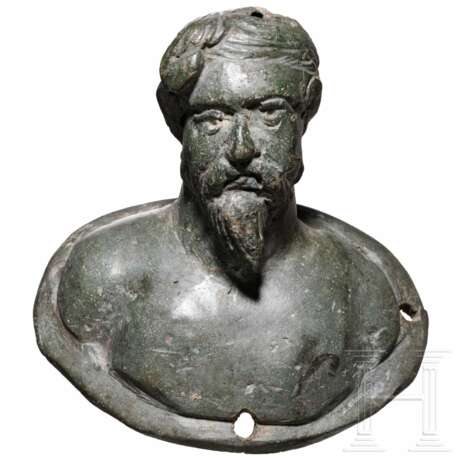Bronzeapplike mit Büste eines Germanen mit Haarknoten, römisch, spätes 2. Jhdt. n. Chr.
19.11.2024 10:00UTC +01:00
Classic
Prix de départ
2000EUR € 2 000
| Auctioneer | Hermann Historica |
|---|---|
| Lieu de l'événement | Allemagne, Grasbrunn / München |
| Commission | 25 % |
Archive
La vente aux enchères est terminée. Vous ne pouvez plus enchérir.

ID 1323309
Lot 4098 | Bronzeapplike mit Büste eines Germanen mit Haarknoten, römisch, spätes 2. Jhdt. n. Chr.
Aus ovaler Basis mit drei Befestigungslöchern am linken, rechten und unteren Rand hervorragende Büste eines germanischen Kriegers mit nacktem, muskulösem Oberkörper, dessen minimal nach rechts gewandten bärtigen Kopf eine Frisur mit sogenanntem "Suebenknoten" auszeichnet. Der barbarische Krieger ist damit in der römischen Wahrnehmung aufgrund festgelegter Bildschemata eindeutig als Germane gekennzeichnet. Die Ausarbeitung von Gesicht und anatomischen Details ist von überdurchschnittlicher Qualität und die naturalistische Darstellung ähnlich einem vergleichbaren Stück aus dem slowakischen Fürstengrab von Musov spricht für eine Datierung in die Markomannenkriege des späten 2. Jhdts. Frühere Darstellungen, z. B. an den Kesseln von Kariv oder Czarnowko, sind stärker stilisiert. Auch vorliegende Applike war sicherlich Bestandteil eines Kessels. Eine vom Hinterhaupt ausgehende Manschette reichte bis zur Wand des Kessels und schloss in dem zwischen Nacken und Manschette liegenden Zwischenraum einen massiven Ring ein, der ursprünglich um die Applik herum hing und im hochgeklappten Zustand zum Aufhängen des Kessels diente.
Die Applik besitzt eine wunderschön glänzende olivgrüne Patina. Winzige Hiebspuren auf Nase und linker Wange, ein kleiner Ausbruch auf dem Scheitel des Kopfes. Der attraktive Gesamteindruck der hochwertigen Applik wird dadurch jedoch kaum geschmälert. Höhe 7,8 cm. Breite 7,3 cm.
Provenienz: Süddeutsche Privatsammlung, übernommen in den späten 90er Jahren aus der Sammlung des Vaters.
A Roman bronze appliqué with the bust of a Germanic warrior with topknot, late 2nd century A.D.
A Roman bronze appliqué with the bust of a Germanic warrior with topknot, late 2nd century A.D.
On an oval base with three fastening holes on the left, right and lower edge. Outstanding bust of a bearded Germanic warrior with a naked, muscular torso, his head turned slightly to the right, crowned with what is referred to as a "Suebian knot" hairstyle. The barbarian warrior is thus clearly identified as a Germanic in the Roman perception on the basis of fixed image schemata. The delineation of the face and anatomical details is of above-average quality and the naturalistic depiction, reminiscent of a comparable piece from the Slovakian king's grave of Mušov, suggest that it dates from the Marcomannic Wars in the late 2nd century. Earlier representations, such as those on the cauldrons of Kariv or Czarnówko, are more highly stylised. This appliqué was also certainly part of a cauldron. A sleeve extended from the back of the head to the side of the cauldron and enclosed a massive ring in the space between the neck and the sleeve. The ring originally hung around the appliqué and would be folded up in order to hang up the cauldron.
The appliqué has an exquisite, gleaming, olive green patina. Miniature impact marks on the nose and left cheek, a small chip on the crown of the head. The attractive overall impression of the first-class appliqué is hardly diminished, however. Height 7.8 cm. Width 7.3 cm.
Provenance: South German private collection, inherited from the collection of the consignor's father in the late 1990s.
Condition: I -
| Lieu d'origine: | Empire romain |
|---|
| Lieu d'origine: | Empire romain |
|---|
| Adresse de l'enchère |
Hermann Historica Bretonischer Ring 3 85630 Grasbrunn / München Allemagne | ||||||||||||||
|---|---|---|---|---|---|---|---|---|---|---|---|---|---|---|---|
| Aperçu | |||||||||||||||
| Téléphone | +49 (0)89 5472 649 0 | ||||||||||||||
| Fax | +49 (0)89 5472 64999 | ||||||||||||||
| Commission | 25 % | ||||||||||||||
| Conditions d'utilisation | Conditions d'utilisation | ||||||||||||||
| Heures d'ouverture | Heures d'ouverture
|


